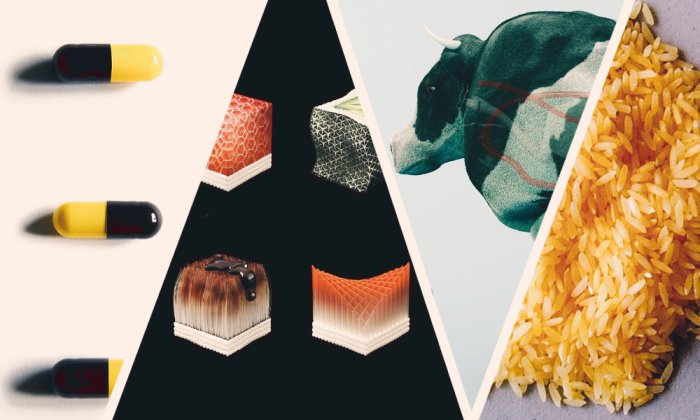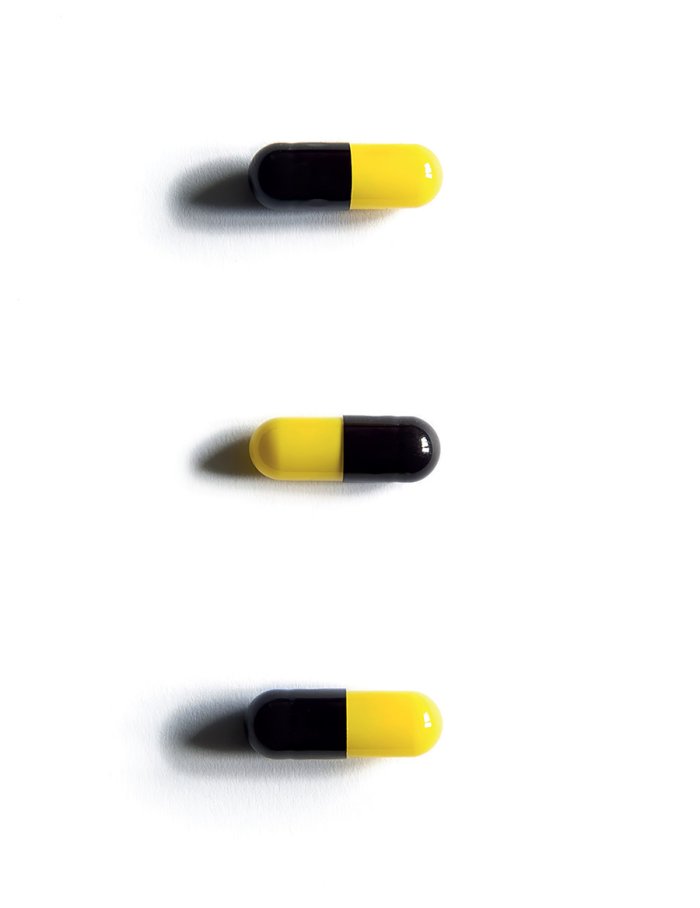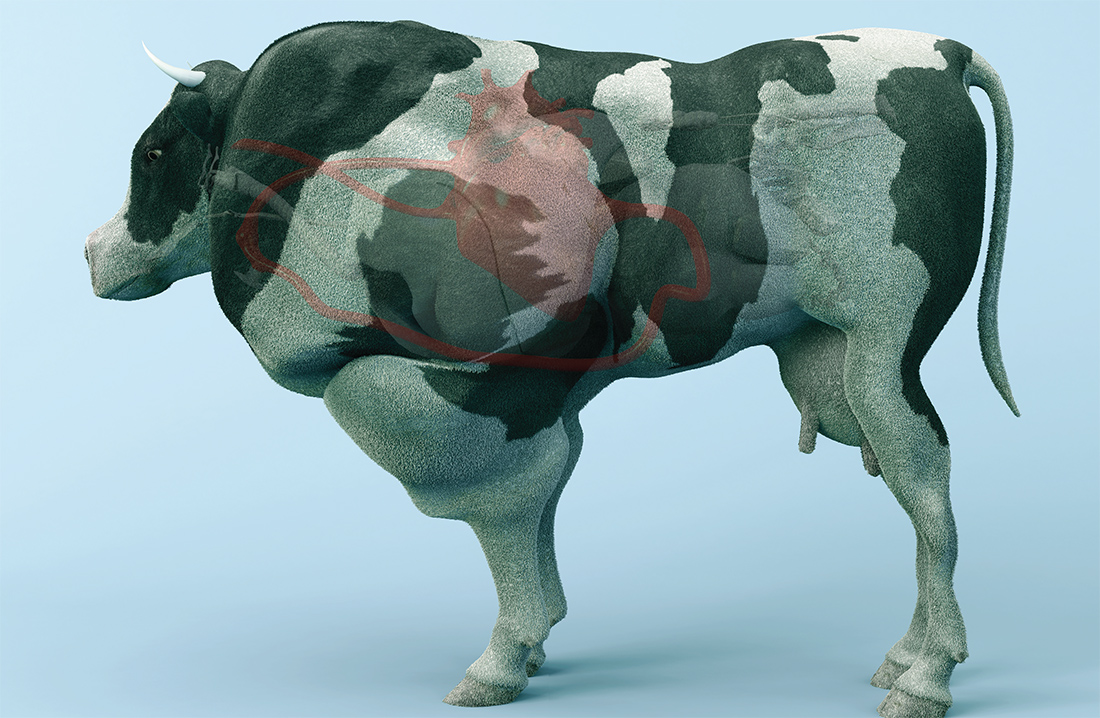Whereas the meal in a tablet stays a dream of science fiction, new and intriguing concepts proceed to emerge.

By: Zane Cerpina & Stahl Stenslie
Dwelling with out starvation, with nutritious and attractive meals in abundance, might be our oldest and most common dream. Historical Greeks instructed legends about ambrosia, the gods’ legendary meals that offered immortality to anybody who consumed it. The Greek poet Homer wrote about fruits that had been produced with out the necessity for farming. And the medieval fantasyland Cockaigne portrayed tasty dishes that reproduced by themselves, flowed down rivers, and fell from the skies with no effort. Centuries later, thanks in nice half to a deep-pocketed food industry, we haven’t stopped looking for the one and true “superfood.” Right here, we provide a glimpse of how this long-awaited superfood of the longer term may look.
Cockroach Milk
The seek for the last word superfood has led to some actually wild scientific research and speculations about meals futures, even when the meals in query is of pure origin. A research paper from 2018 speculated that the following superfood is likely to be one thing fairly surprising — cockroach milk. In response to the article, the cockroach species Diploptera functata has advanced the trait of viviparity: It could possibly present vitamins to creating embryos throughout the gestation interval. It produces a substance that accommodates protein crystals claimed to be extra nutritious than any animal milk. Even when cockroach milk was extra nutritious than cow’s milk, one query stays: methods to milk a cockroach?
The scientist and researcher Leonard Chavas claims that the method is energy-intensive and time-consuming. Whereas the tactic itself is comparatively straightforward, the milk-like substance might be harvested solely on the stage of the cockroach’s lifespan when it begins to lactate for its offspring. In contrast to cows, the cockroach must be killed to be able to extract the milk crystals from its midgut. He speculates that milking simply a few cockroaches is more likely to take half a day. If the estimation is right, you would wish to kill a thousand cockroaches to acquire solely three and a half ounces of the product.
Even when cockroach milk is the last word superfood and accommodates 4 occasions extra protein than cow’s milk, it’s unlikely to look on grocery store cabinets sooner or later. Whereas the promise of cockroach milk has taken public debate by storm, in actuality, large-scale manufacturing is more likely to be each unsustainable and inadequate. It is likely to be simpler to drink 4 occasions extra cow’s milk to achieve the identical power and protein worth.
Meal in a Capsule
Nature holds many potential superfoods, however within the Anthropocene, sustaining the world solely on meals of pure origin will probably be simply as problematic as feeding everybody with cockroach milk. When nature as we all know it adjustments (at greatest) or disappears (at worst), a future superfood is more likely to be produced synthetically, a recurring theme in science fiction.

The most well-liked staple meals of sci-fi, and maybe the last word techno-utopian fantasy, is the meal in a tablet. In response to meals researcher and author Warren James Belasco, our fascination with the meal in a tablet goes again to the Neolithic age. As soon as people began domesticating grains and legumes, they noticed them as minute meals with immense powers. A single seed or a single grain can produce a considerable amount of meals. Subsequently, every turns into enormously vital. Belasco additionally attracts parallels to charms and gems that in folklore possess magical qualities regardless of their miniaturization. Equally, the meal in a tablet guarantees a snug and nearly magical repair to essentially the most timeless and common human downside — the wrestle for meals.
Early speculations on the meal-in-a-pill idea date again to the Eighties. Within the satirical novel “The Republic of the Future” (1887), for instance, American author Anna Bowman Dodd describes New York within the 12 months 2050, the place meals tablets are delivered on to flats. Dodd explains that the meals tablets freed ladies of the longer term from working within the kitchen: “When the last pie was made into the first pellet, women’s true freedom began.”
In 1894, chemist Marcellin Berthelot predicted that within the 12 months 2000, people would eat artificial meals within the type of a pill.
However the idea of a meal in a tablet didn’t originate merely out of frustrations with the labor-intensive means of cooking. The science-based claims in favor of this idea had been already laid down within the Nineties. In 1894, chemist Marcellin Berthelot predicted that within the 12 months 2000, people would eat artificial meals within the type of a pill. He believed that conventional staple meals would now not be grown naturally however can be manufactured utilizing artificial chemistry from carbon, hydrogen, oxygen, and nitrogen.
Whereas many meals right this moment are produced utilizing artificial elements, full meal-replacement tablets are nowhere in sight. Scientists are nonetheless engaged on a option to match all of the dietary and caloric wants into one standardized capsule. It’s estimated that with present information and applied sciences, we must eat greater than 450 tablets a day to achieve the required dietary consumption. For now, a meal in a tablet stays a distant dream of rendering mankind impartial of nature’s assets and potential failures.
Golden Rice and Different Silver Bullets
Whereas the reductionist strategy to feed the world continues to achieve its attraction, we extra steadily select to supersize and superupgrade already current meals sources. Genetic modification strategies are sometimes utilized on this quest to reinforce our favourite staples. The thought of modifying a meals supply to succeed in its full potential additionally results in a promise of straightforward fixes and absolute options for growing meals safety on a world stage. The result’s extremely debated genetically upgraded meals (genetically modified organisms, or GMOs), that are hailed for his or her monumental potential to extend meals safety and criticized as magical options (that’s, silver bullets) to sophisticated meals safety points.
Arguably essentially the most controversial and publicly debated silver bullet challenge is golden rice — a genetically engineered kind of Asian rice (Oryza sativa) that may biosynthesize beta-carotene that’s metabolized into vitamin A in the human body. The thought to genetically enhance the rice plant was born within the Nineties as an answer for ending vitamin A deficiency and minimizing malnutrition, particularly in creating international locations. As rice is recurrently consumed by greater than half of the worldwide inhabitants, it’s speculated that golden rice may have a major influence on meals safety on a world scale.
The silver bullet strategy has additionally been utilized to different vegetation, together with the potato (Solanum tuberosum L.). Utilizing strategies just like these used to provide golden rice, researchers may improve the potato with provitamin A and vitamin D, leading to a golden potato. If profitable, it may enhance meals safety and assist tackle preventable childhood blindness and other illnesses, particularly in international locations the place the potato is already an vital staple. Whereas the debates proceed about GMO use in agriculture, we’re more likely to see, according to the Golden Rice Humanitarian Board, “neither high folate rice, nor high iron rice, nor high zinc rice, nor Golden Rice” examined to their full potential as superfoods.
Supersizing Meals
The broiler chicken has grow to be a serious image of human skills to engineer, supersize, mass-produce, and switch a selected species into a world staple meals. Does this imply people have modified the rooster right into a superfood?

The human position within the growth of the fashionable broiler rooster is thoughtfully explored by artist Andreas Greiner in his 2019 work “Monument for the 308.” Greiner confronts the viewers with a big sculpture of a broiler rooster within the dimension of a dinosaur. It’s a 3D-printed sculpture based mostly on a high-definition computerized tomography (CT) scan of a useless Ross 308 rooster, a standard breed of broiler chook. Compared to its prehistoric ancestor, the bird-like dinosaur Archaeopteryx, the Ross 308 rooster will not be extinct, and it has by no means been greater in its particular person dimension or in its recognition within the world inhabitants. Nevertheless, the chook can now not survive with out people. Subsequently, Greiner’s monumental work, which resembles a typical dinosaur displayed in a nationwide historical past museum, “acknowledges the reciprocal dependency between this animal and humans.”
The work represents how people have manipulated the rooster’s anatomy to serve growing ranges of worldwide meat consumption. If the fashionable rooster is extra of a genetically engineered product than a naturally occurring superfood, what additional transformations will this chook bear sooner or later? What would be the subsequent improve to our industrially farmed animals?
Redesigning Farm Animals
So long as industrial farming exists, it has enormous negative environmental effects on carbon emissions and power, water, and land overuse. If people are to proceed farming animals for meat and milk within the Anthropocene, the trade have to be radically reinvented. The reply to sustainable industrial farming sooner or later is likely to be merely utilizing cattle for the manufacturing of extra than simply meat and dairy.
“The Cow of Tomorrow” is impressed by scientific analysis exploring the feasibility of harvesting electrical energy utilizing a miniature hydrodynamic turbine powered by the cardiac output circulation.
In his 2015 challenge “The Cow of Tomorrow,” artist Paul Gong creates a future state of affairs the place already closely redesigned cattle might be additional modified for power manufacturing. Gong proposes implementing a tiny turbine within the artery of the cow, permitting it to make use of the blood circulation to harness power. In response to Gong, the cow is an ideal candidate because of its lengthy historical past of business domestication. Since we now have already genetically modified the cow to reinforce its milk yield, why not look into new duties the animal may presumably do? Whereas “The Cow of Tomorrow” may seem like merely thought-provoking hypothesis, it’s impressed by scientific analysis exploring the technical feasibility of harvesting electrical energy utilizing a miniature hydrodynamic turbine powered by the cardiac output circulation in a peripheral artery.

The artist created the challenge to have a look at the query of whether or not it might be for the higher or worse to additional enhance human management over nature by way of the usage of rising applied sciences. The continued pursuit of genetically engineered superanimals and superplants brings up many moral and ethical questions, in fact. Is there a restrict to how far different species ought to be remodeled to profit human survival? Would creating multipurpose cattle be unethical if it contributed to sustainability? What can be the environmental advantages of upgrading the cow right into a powerhouse? May the power harvested from cattle be used to energy the farming trade? In concept, such ideas may assist make the resource-intensive trade extra self-sufficient. A sensible use of current meals and improvements in biotechnologies can result in our future superfoods being greater than only a supply of vitamin.
Unconventional Superfoods: Spirulina
Genetically modified superfoods are usually not the one meals that people are skeptical about. Even with the fashionable pattern of superfoods, only some have grow to be extensively well-liked. How will we all know what to decide on within the Anthropocene? Many have tried the trending historical superfoods comparable to quinoa and amaranth, which was a staple for Aztecs. Additionally, goji berries, which had been utilized in historical Chinese language medication, appear to have grow to be a culturally accepted snack. Whereas these meals are unlikely to carry any extra dietary worth than different options, there may be one other historical superfood that has been praised for its potential in diets after the ecological disaster — algae.
Spirulina platensis (also called Arthrospira) is a genus of cyanobacteria at the moment gaining world curiosity as a possible future superfood. Till the sixteenth century, it was used as meals by the Aztecs and different Mesoamericans. Immediately, many African countries still use it as a serious protein supply by harvesting it from pure waters, drying it, after which consuming it.
Dried spirulina holds as much as 70 % proteins, which is half greater than soybeans. It additionally accommodates numerous nutritional vitamins and minerals and is taken into account some of the nutritious meals on the planet. Due to its wealthy composition, the United Nations World Meals Convention declared it in 1974 to be the very best meals for the longer term. Spirulina can be more likely to stand up to unsure local weather futures as it may be cultivated in somewhat barren areas, doesn’t want clear recent water, and can gladly develop in extremely saline water as a substitute.
Hypothesis on alternative routes of consuming this superfood within the far future is explored by artists Michael Burton and Michiko Nitta within the 2010 challenge “Algaculture.” “Algaculture” is a speculative future state of affairs that proposes enhancing people with new bodily organs populated by algae. This distinctive symbiotic relationship would enable people to be semiphotosynthetic. Some organisms are identified to enter a coexistence with entities that carry out photosynthesis. The pea aphid (Acyrthosiphon pisum), for instance, is an insect that makes use of pigments to seize daylight and switch it inside its cells for power manufacturing. And the ocean slug Elysia chlorotica eats algal cells to allow photosynthesis. It could possibly sufficiently maintain itself on carbon power for a number of months. May people presumably observe this blueprint of sustainable and self-sufficient feeding? How would a symbiotic human-spirulina relationship change the best way we feed ourselves sooner or later?
As proposed in “Algaculture,” implementing algae throughout the human organ system would, in concept, allow people to hold and produce nutritious meals wherever, even with out the necessity for algae farms. Whereas the challenge is very speculative, it additionally poses the intriguing thought of a closed-loop system based mostly on natural and pure means. As a substitute of upgrading our meals or creating artificial meals substitutes, we will instantly use genetic engineering to remodel our our bodies and the best way we eat.
Sooner or later, customized vitamin may grow to be as widespread as precision medication.
Initially, species of algae seem like the right superfood for the longer term, particularly within the Anthropocene. Nevertheless, these organisms are usually not absolutely suitable with the human physique as meals. In 2016, Soylent needed to recall merchandise that contained a novel ingredient — Chlorella protothecoides algal flour — as a result of allergic response it induced in a number of prospects.
A number of reported uncomfortable side effects raised the alarm concerning the security of utilizing microalgae comparable to spirulina and Chlorella protothecoides on a frequent foundation. Spirulina can be a cyanobacterium, which has been discovered to provide toxins. The documented well being points embrace allergy symptoms, nausea, and vomiting. Extended consumption of concentrated spirulina within the type of tablets may presumably trigger irreversible injury to some organs, together with the kidneys and the liver. It is usually believed that there are nonetheless many compounds that haven’t but been found and correctly examined in microalgae. Selecting the right superfood is not any straightforward process, however what when you knew by design precisely what to eat?
DNA-Customized Superfoods
It is likely to be unimaginable to provide one standardized superfood offering all the required dietary and medicinal properties to all equally. As a substitute of searching for only one, may we develop customized meals that solely match every particular person’s wants?
An early inspiration for customized delicacies might be discovered within the authentic collection of the present “Star Trek”(1966–1969), the place meals was created utilizing a Meals Synthesizer — a tool that turned totally different uncooked supplies into edible natural matter. The meals synthesizer was in a position to make a wide range of meals with any style. Later, “Star Trek: The Next Generation” (1987–1994) envisioned the Replicator, an upgraded next-generation gadget that was preprogrammed to make 4,500 various kinds of meals utilizing a molecular matrix. Whether it is doable to provide a wide range of meals from just a few primary elements, may we additionally print superfoods? And if future superfoods are based mostly on information recipes, may we even individualize our meals on a private stage?
We’re nonetheless within the early phases of understanding the connection between the human genome, vitamin, and well being. However some nutritionists have already begun to use genomics tests to create individual assessments, and sooner or later, customized vitamin may grow to be as widespread as precision medication. Firms specializing in genetic testing additionally supply their shoppers custom-made well being suggestions based mostly on saliva, blood, and fecal samples. It’s now doable to assemble meal plans, meals complement packs, and weight-loss suggestions based mostly on particular person information. How would the way forward for the meals trade look if ordering the right meal was doable by way of customized evaluation — and if making that meal was so simple as urgent a button on a Meals Synthesizer just like the one on “Star Trek”?
The Japanese design studio Open Meals explores hyperpersonalization within the meals trade by way of its restaurant idea Sushi Singularity. Set to open in Tokyo, Sushi Singularity will apparently serve customized meals based mostly on the company’ particular person well being identification (HID). Previous to the restaurant go to, company will obtain a check package for acquiring their HID by way of DNA, urine, and intestinal assessments. The restaurant guarantees to serve hyperpersonalized sushi dishes becoming every individual’s particular person dietary wants. Past particular person dietary necessities, the way forward for customized superfood may in concept be additional custom-made based on environmental circumstances and the supply of native assets.
Future superfoods should fulfill many projections. They need to present well being advantages for individuals, contribute to the survival of the species, improve our consuming experiences, and set a brand new course for the connection between people and nature. Whereas traditional superfoods (such because the meal in a tablet) stay a dream of science fiction, new weird options emerge, even when lots of them (together with cockroach milk) are unlikely to be produced in massive sufficient portions to influence our food plan.
This a lot is simple: A big flood of possible catastrophes looms over us within the age of the Anthropocene — the Age of Man. On this new geological epoch, it’s we people who’re reshaping the planet, impacting geology and ecosystems alike. The variety of self-inflicted doomsday eventualities grows by the day, confronting us with an limitless chain of world-ending armageddons. No surprise the top of humanity seems nigh. Or? This coming period may also be seen as a possibility for change, new concepts, and a constructive future. We should seize the scorching moments that lie forward of us. The Anthropocene will put our considering, creativity, and ingenuity to the check. Allow us to welcome that and throw ourselves headfirst into the waves of change.
Zane Cerpina is a curator and author working inside experimental and digital arts.
Stahl Stenslie is a curator and researcher specializing in experimental and rising aesthetics and disruptive applied sciences who has held positions at Academy of Media Arts Cologne, Oslo Nationwide Academy of the Arts, and Aalborg College.
Cerpina and Stenslie are the authors of “The Anthropocene Cookbook: Recipes and Opportunities for Future Catastrophes,” from which this text is customized.
‘ The preceding article may include information circulated by third parties ’
‘ Some details of this article were extracted from the following source thereader.mitpress.mit.edu ’

